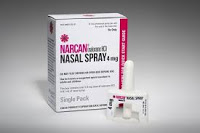New designer opioid is linked to overdose deaths in Illinois and Indiana; Cincinnati coroner says she plans to start testing for it

A new synthetic opiate, isotonitazene, may require more than a usual dose of naloxone (Narcan) to restore breathing.
—–
A new synthetic opiate is showing signs of penetrating new markets, Terry DeMio reports for the Cincinnati Enquirer.
The drug has been detected in the blood of people in Illinois and Indiana, where it was mixed with cocaine, and other reports show it was also found during a drug raid last year on Canada’s eastern seaboard, DeMio reports. The drug, called isotonitazene, comes in a white or off-white powder form, sometimes pressed into counterfeit opioid pills.
Dr. Lakshmi Sammarco, coroner for Hamilton County, Ohio, which includes Cincinnati, told DeMio that she plans to get a standard test for this new drug so that it can be added to toxicity screens for those who die from overdoses in the county.
“We only see what we test for,” Sammarco told DeMio. “We’re going to start looking for it. We will probably look back at some overdose deaths to see whether it was present.”
DeMio writes that “isotonitazene is not a fentanyl analog, the powerful synthetic opiates that have been plaguing Ohio and Kentucky and other parts of the United States during recent years of the opioid epidemic.” Sammarco told her, “It is derived from etonitazene, a powerful analgesic opioid first identified in the 1950s that is explicitly illegal.”
And because it isn’t yet on the U.S. Drug Enforcement Administration‘s controlled substances list, that means it’s not illegal, DeMio reports.
DeMio warns that like any opioid, this new drug can cause respiratory failure, and some reports say it is so strong that it may require more than a usual dose of naloxone (branded as Narcan) to restore breathing.
Dr. Mina “Mike” Kalfas, a Northern Kentucky addiction specialist, told DeMio that the appearance of this and other designer drugs emphasizes the need for treatment, prevention and harm reduction, since new drugs keep showing up on the market. For example, he noted that fentanyl and methamphetamine have unsurped most heroin use in the region.
“Just as soon as we kill one rat, another one pops up,” Kalfas told DeMio. “The attitude of ‘Let’s just get rid of it’ doesn’t work.”
Newtown Police Chief Tom Synan, a coordinator with the Hamilton County Addiction Response Coalition who takes part in periodic meetings with the Office of National Drug Control Policy about new drugs, told DeMio that he was unaware of isotonitazene, but was not surprised that a new drug had slipped into the supply.
“We will always be reacting when it comes to changes in the drug supply,” he told DeMio. “It’s why we have to make sure we have the resources needed to keep people alive and connect them to services – so that we can reduce deaths and reduce harm.”